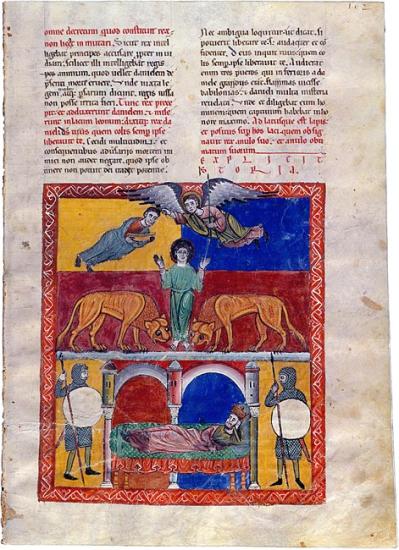
Daniel in the Lions' Den
Beatus of Liébana
Las Huelgas Apocalypse
Purchased by Pierpont Morgan, 1910
Darius appointed Daniel as one of three leaders to which the governors of the kingdom would be accountable. But others, envious of Daniel, had Darius publish a decree so that all who ask any petition of any god or man for thirty days will be cast into the den of lions. They then informed Darius that Daniel prayed three times daily, and the king had no choice but to cast him into the den of lions. The king said to Daniel, "Your God, whom you always serve, he himself will free you." And the king could not eat or sleep, going quickly to the den at sunrise. He tearfully cried out to Daniel, "Has your God freed you from the lions?" And Daniel answered, "O king, live forever. My God has sent his angel, who closed the mouths of the lions, and they have not harmed me, because before him justice has been found in me, and, even before you, O king, I have committed no offense." (Dan. 6)
Darius lies sleepless while Daniel's feet are licked by the lions. The hovering angel transports Habbakuk by the hair so that he can bring a bowl of food to Daniel. This episode is derived from earlier illustrated Bibles, as it is not mentioned in the manuscript. (It was later added to the Book of Daniel, at the end of the story of Bel and the Dragon; Dan. 14:32–36).
The Apocalypse, or Book of Revelation, is not only the last Book of the New Testament, but its most difficult, puzzling, and terrifying. It provided challenges to medieval illustrators and was the source for a number of popular images, such as Christ in Majesty, the Adoration of the Lamb, and the Madonna of the Apocalypse and contributed to the widespread use of the Evangelists' symbols.
Selected images from Apocalypse Then: Medieval Illuminations from the Morgan, an exhibition held at the Morgan are presented here. The exhibition celebrates the completion of a facsimile of the Morgan's Las Huelgas Apocalypse—the latest dated (1220) and largest surviving manuscript of a Spanish tradition of illuminated commentaries on the Apocalypse by the monk Beatus of Liébana. The series of manuscripts constitutes Spain's most important contribution to medieval manuscript illumination.
The Las Huelgas Apocalypse contains three sections: the prefatory cycle, the Apocalypse, and the Book of Daniel.
In addition to forty-nine images from the Las Huelgas Apocalypse, six images from other manuscripts in the Morgan's collections, including the earliest Beatus painted by Maius and one by the Master of the Berry Apocalypse, are in this presentation.
